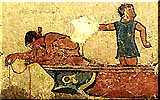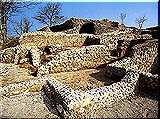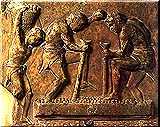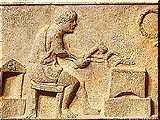|

The
servile class
The popular quarters were inhabited by the servile class:
these were free men and women, who enjoyed civil rights such
as property, but who did not play a part in the political
leadership of the country. Today we can identify them in funeral
inscriptions as their names do not contain any mention of
the family group they belong to, as was the case of the noble
classes. The servile class, from the 4th century BC, was at
the origin of social tumult, with the aim of obtaining political
rights, claims that at times had violent epilogues with the
intervention of the Romans to restore the established order.

Dwellings
The materials used to build the homes of the popular class
did not differ greatly from those used for the dwellings of
the noble classes, namely stone foundations with clay or unbaked
brick walls, supported by a wooden framework. The houses were
built side by side and grouped together; the rooms were small
and buildings low. According to religious precepts, the streets
should have intersected at right angles. In actual fact, as
the cities were often built on rises, this was impossible
and the inhabited areas took shape adapting themselves to
the characteristics of the location, giving rise to an entanglement
of narrow winding alleys.

The
slaves
Like all ancient civilizations, the Etruscans also used slaves
for their labour force, and they provided low cost manpower
that could nevertheless also be highly specialized. The slaves
were men and women who had no civil or political rights but
were considered objects of property. The commonest occupations
in the cities for them were as domestic workers in the homes
of the aristocratic class, or they worked in the craft workshops;
in the country, they worked in agriculture or in the mines,
extracting metals. The main sources of slaves were wars and
raids in enemy territory. The slaves were not usually ill-treated
as they were considered valuable goods and the death of a
slave was seen as a serious economic loss.

Handicrafts
The workshops of the craftsmen, bustling with productive and
trading activities, lined the streets and alleys of the cities.
Terracotta recipients and vases of all shapes and sizes, inspired
by Greek taste, bronze objects and tools, refined jewels made
of gold and other precious metals, were all made in the workshops.
These products were bought on the spot or shipped for sale
to far-off peoples. The
craftsmen working in the Etruscan cities included, in addition
to local inhabitants, people belonging to other populations,
especially Italics and Greeks whose skills were highly appreciated.
In the largest workshops there were also specialized slaves;
many mass-produced objects have in fact been found which suggest
that production was organized almost on a proto-industrial
level. The most typical ceramics of the vast Etruscan production
was the bucchero ware. These vases were characterized by the
shiny black colour of their surface, due to the techniques
of production and firing.
In
the most ancient period, the production of bucchero ware,
typical of the city of Caere, was characterized in particular
by the fine walls of the vases. Subsequently, alongside the
fine bucchero ware came the heavy bucchero ware, with thick
walls and relief or applied decorations. Mirrors, found in
hundreds in the necropolises, deserve particular attention
for the exquisiteness of their workmanship. The commonest
model of mirror was round with a handle. The back of the bronze
surface was engraved or worked in relief, usually with mythological
subjects from Greek art, or it was covered with inscriptions.
The
production of gold jewellery and objects, in which the Etruscans
showed a high degree of technical elaboration, capable of
exploiting the expressive possibilities of the metal, was
extremely rich and deservedly famous. The most flourishing
period was between the mid-7th century and the end of the
6th century BC, in Vetulonia and Vulci. The taste for the
excessive and emphatic effects also triumphed in jewellery,
both in the use of ornamental, floral, figurative and geometric
motives, and in the use of various techniques of workmanship,
often combined together. These techniques included engraving,
repoussage, fusion, filigree and, above all, granulation,
which consisted of applying tiny grains of gold soldered to
one another to the surface of the metal, thus multiplying
the effect of the play of the light.
|



